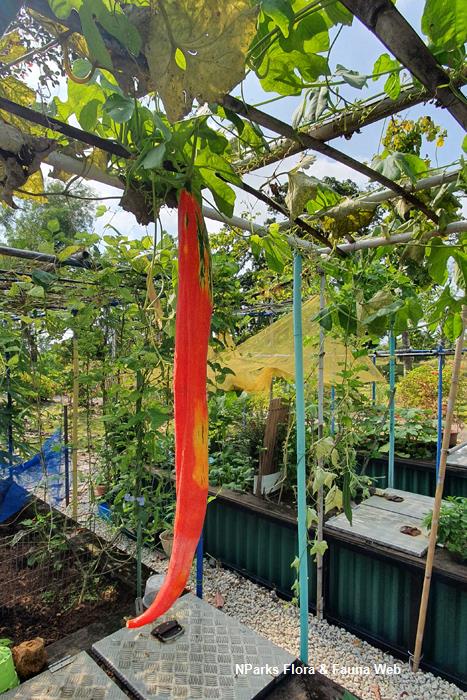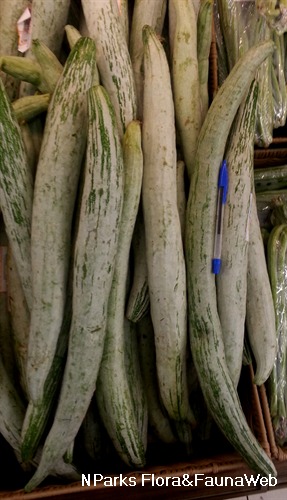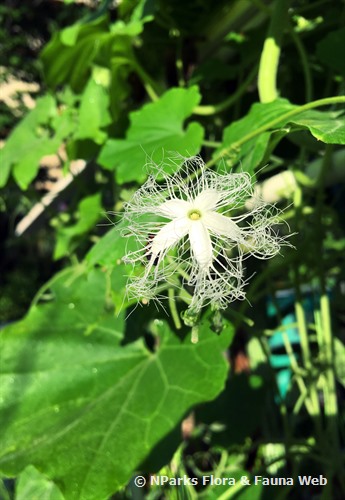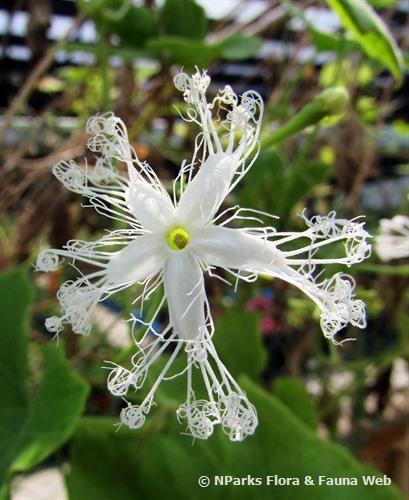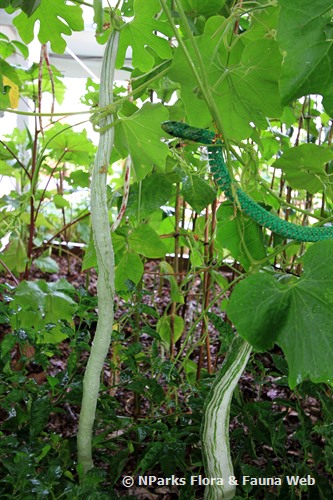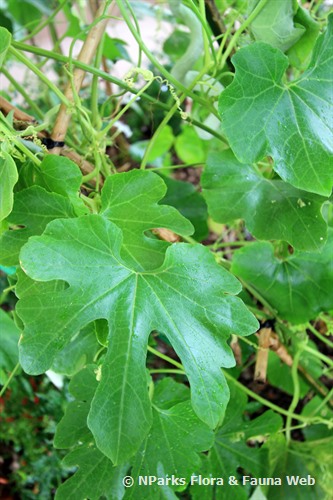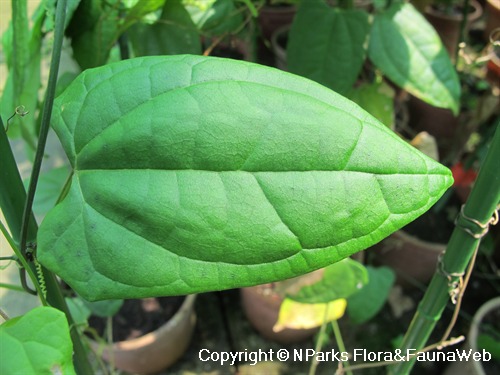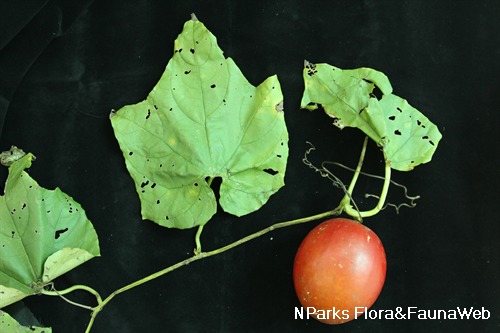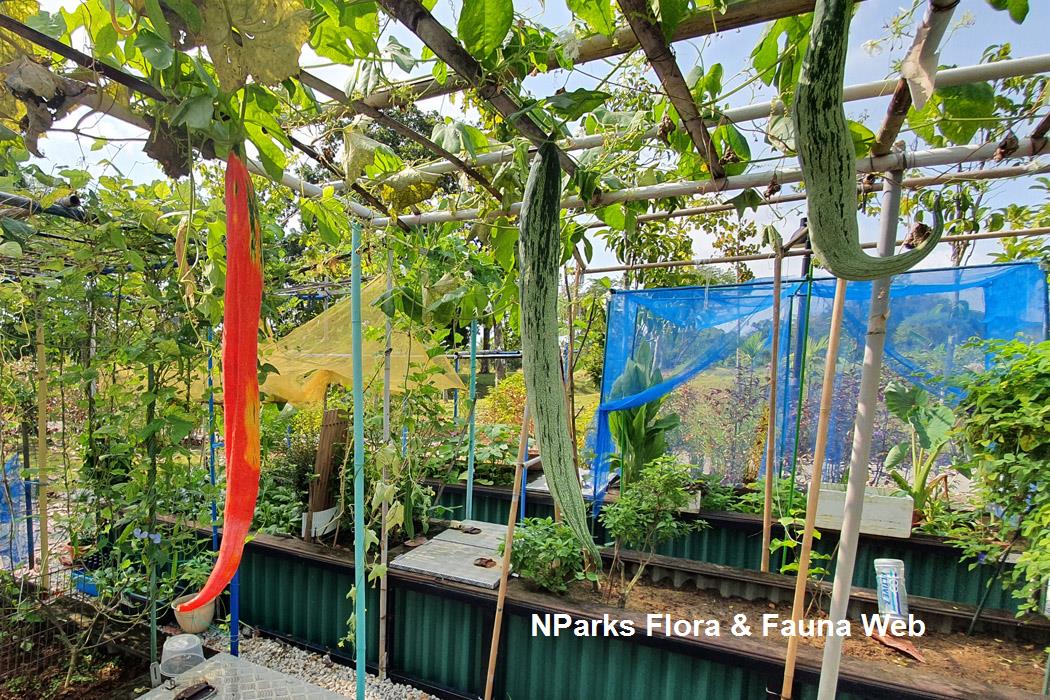
Back
Trichosanthes cucumerina L.
| Family Name: | Cucurbitaceae |
| Synonyms: | Trichosanthes anguina L. |
| Common Name: | Snake Gourd, 蛇瓜, 蛇豆, 蛇丝瓜 |
Name
Classifications and Characteristics
| Plant Division | Angiosperms (Flowering Seed Plants) (Dicotyledon) |
|---|---|
| Plant Growth Form | Climber |
| Lifespan (in Singapore) | Perennial, Annual |
| Mode of Nutrition | Autotrophic |
Biogeography
| Native Distribution | Southern and eastern Asia, Southeast Asia, Australia and western Pacific |
|---|---|
| Native Habitat | Terrestrial |
| Preferred Climate Zone | Tropical, Sub-Tropical / Monsoonal |
| Local Conservation Status | Non-native (Horticultural / Cultivated Only) |
Description and Ethnobotany
| Growth Form | Annual climber. |
|---|---|
| Foliage | The leaves are approximately round to bean-shaped with typically about 5 deep, obovate lobes. The leaf underside is densely covered in fine, downy hairs. |
| Flowers | Female flowers occurs singly, while 8-15 male flowers are grouped in a spike-like inflorescence known as a raceme.The petal edge of female flowers is lined with white, tendril-like hairs which unfurl to form a lacy pattern. |
| Fruit | Long, cylindrical or sometimes twisted fruit has smooth skin with tapered ends (1-2 m long, 3-4 cm wide). The seeds are red. |
| Cultivation | Flowering of snake gourd starts about 5 weeks after planting; the male flowers appear first, followed by female flowers about 3 days later. The flower opens in the evening or early morning. In early-maturing cultivars, you can harvest gourds from about 7-15 weeks after planting. |
| Ethnobotanical Uses | Edible Plant Parts : Edible Fruits, Edible Leaves Food (Fruit or Vegetable): Immature fruits of cultivated forms are eaten boiled as vegetable. Young shoots and leaves are also edible. Medicinal: The roots and seeds are used medicinally for treating diarrhea. |
Landscaping Features
| Landscape Uses | Parks & Gardens, Trellis / Arbour / Pergola |
|---|---|
| Thematic Landscaping | Economic Garden |
| Plant & Rootzone Preference or Tolerance Remarks | It does not tolerate dry soil but is also sensitive to waterlogging. |
Plant Care and Propagation
| Light Preference | Full Sun |
|---|---|
| Water Preference | Moderate Water |
| Rootzone Tolerance | Moist Soils, Well-Drained Soils |
| Pruning | Prune the lateral branches to promote fruit production. |
| Propagation Method | Seed |
| Propagation Method Remarks | The white or light-coloured seeds are very unlikely to germinate. Seeds should be soaked in water overnight before planting to hasten germination. |
| Seed / Spore Germination Rate | 60% |
Foliar
| Foliage Retention | Evergreen |
|---|---|
| Mature Foliage Colour(s) | Green |
| Mature Foliage Texture(s) | Thin |
| Foliar Modification | Foliar Tendril |
| Foliar Type | Simple / Unifoliate |
| Foliar Arrangement Along Stem | Alternate |
| Foliar Attachment to Stem | Petiolate |
| Foliar Shape(s) | Non-Palm Foliage (Orbicular / Round, Reniform) |
| Foliar Venation | Palmate |
| Foliar Margin | Palmately Lobed |
| Foliar Apex - Tip | Acute, Rounded |
| Foliar Base | Auriculate |
Floral (Angiosperm)
| Flower & Plant Sexuality | Unisexual Flowers , Monoecious |
| Flower Colour(s) | White |
|---|
| Flower Texture(s) | Hairy / Hirsute |
| Flower Grouping | Solitary, Cluster / Inflorescence |
| Flower Location | Axillary |
| Inflorescence Type | Raceme |
Fruit, Seed and Spore
| Mature Fruit Colour(s) | Green - Light Green, White |
|---|---|
| Mature Fruit Texture(s) | Smooth |
| Mature Seed Colour(s) | Brown, Red |
| Seed Quantity Per Fruit | Numerous (>20) |
Image Repository
Others
| Master ID | 31559 |
|---|---|
| Species ID | 5958 |
| Flora Disclaimer | The information in this website has been compiled from reliable sources, such as reference works on medicinal plants. It is not a substitute for medical advice or treatment and NParks does not purport to provide any medical advice. Readers should always consult his/her physician before using or consuming a plant for medicinal purposes. |

